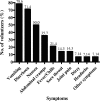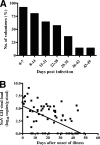Norovirus excretion in an aged-care setting
- PMID: 18417655
- PMCID: PMC2446857
- DOI: 10.1128/JCM.02198-07
Norovirus excretion in an aged-care setting
Abstract
Norovirus genogroup II excretion during an outbreak of gastroenteritis was investigated in an aged-care facility. Viral shedding peaked in the acute stage of illness and continued for an average of 28.7 days. The viral decay rate was 0.76 per day, which corresponds to a viral half-life of 2.5 days.
Figures


Similar articles
-
A norovirus outbreak in a nursing home: norovirus shedding time associated with age.J Clin Virol. 2013 Feb;56(2):96-101. doi: 10.1016/j.jcv.2012.10.011. Epub 2012 Nov 13. J Clin Virol. 2013. PMID: 23153821
-
Long-term features of norovirus gastroenteritis in the elderly.J Hosp Infect. 2004 Dec;58(4):286-91. doi: 10.1016/j.jhin.2004.07.001. J Hosp Infect. 2004. PMID: 15564004
-
Outbreak of norovirus gastroenteritis involving multiple institutions.Jpn J Infect Dis. 2007 May;60(2-3):146-7. Jpn J Infect Dis. 2007. PMID: 17515654 No abstract available.
-
Heterogeneity in norovirus shedding duration affects community risk.Epidemiol Infect. 2013 Aug;141(8):1572-84. doi: 10.1017/S0950268813000496. Epub 2013 Mar 18. Epidemiol Infect. 2013. PMID: 23507473 Free PMC article. Review.
-
[Viral food-borne diseases caused by norovirus].Shokuhin Eiseigaku Zasshi. 2005 Dec;46(6):235-45. doi: 10.3358/shokueishi.46.235. Shokuhin Eiseigaku Zasshi. 2005. PMID: 16440783 Review. Japanese. No abstract available.
Cited by
-
Temporal Evolutionary Dynamics of Norovirus GII.4 Variants in China between 2004 and 2015.PLoS One. 2016 Sep 20;11(9):e0163166. doi: 10.1371/journal.pone.0163166. eCollection 2016. PLoS One. 2016. PMID: 27649572 Free PMC article.
-
A decade of norovirus disease risk among older adults in upper-middle and high income countries: a systematic review.BMC Infect Dis. 2015 Oct 14;15:425. doi: 10.1186/s12879-015-1168-5. BMC Infect Dis. 2015. PMID: 26467099 Free PMC article. Review.
-
Specimen collection and confirmation of norovirus outbreaks.Emerg Infect Dis. 2011 Aug;17(8):1553-5. doi: 10.3201/eid1708.101815. Emerg Infect Dis. 2011. PMID: 21801649 Free PMC article.
-
Epidemiologic, Virologic, and Host Genetic Factors of Norovirus Outbreaks in Long-term Care Facilities.Clin Infect Dis. 2016 Jan 1;62(1):1-10. doi: 10.1093/cid/civ747. Epub 2015 Oct 26. Clin Infect Dis. 2016. PMID: 26508509 Free PMC article.
-
Pattern of circulation of norovirus GII strains during natural infection.J Clin Microbiol. 2014 Dec;52(12):4253-9. doi: 10.1128/JCM.01896-14. Epub 2014 Oct 1. J Clin Microbiol. 2014. PMID: 25274996 Free PMC article.
References
-
- Atmar, R. L., and M. K. Estes. 2006. The epidemiologic and clinical importance of norovirus infection. Gastroenterol. Clin. N. Am. 35275-290. - PubMed
-
- Blanton, L. H., S. M. Adams, R. S. Beard, G. Wei, S. N. Bulens, M. A. Widdowson, R. I. Glass, and S. S. Monroe. 2006. Molecular and epidemiologic trends of caliciviruses associated with outbreaks of acute gastroenteritis in the United States, 2000-2004. J. Infect. Dis. 193413-421. - PubMed
Publication types
MeSH terms
LinkOut - more resources
Full Text Sources
Medical

